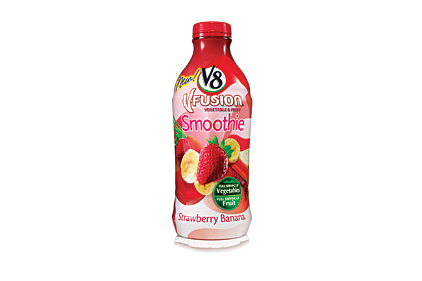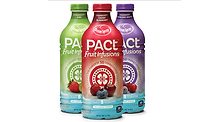Vegetable juices work behind the scenes


|
|
Campbell Soup Co. launched V8 V-Fusion Smoothies last fall, which feature fruit flavors and include a full serving of fruit and vegetables in each 8-ounce portion. |
Children can get crafty when it comes to eating vegetables. They can push them around their plates to try to make it look like they’ve eaten more than they have; or they might hide them in their napkins or underneath other food. The last resort for most kids is actually eating the vegetables. However, manufacturers and parents alike are hoping that incentives and constant exposure to vegetables might help these picky eaters adapt.
A new study by the Produce for Better Health Foundation (PBH), Hockessin, Del., found that children who are repeatedly exposed to vegetables and offered rewards when they eat them will significantly increase their liking and intake of those vegetables.
Lucky for parents, hybrid fruit-and-vegetable drinks are popping up on shelves nationwide, providing the sweet taste kids want with the nutrients of both fruits and vegetables. In fact, the biggest request that Vegetable Juices Inc. receives from its customers is for “stealth health,” says Elizabeth Doyle, president and chief executive officer of the Bedford Park, Ill.-based company.
“[Beverage-makers] want the nutritional value of the vegetables; they want the antioxidants, the nutrients, the vitamins that come with it, and they’re also really looking for claiming a vegetable serving within the beverages,” she says.
Two types of these nutritious beverages have become popular: ones that capitalize on the enhanced flavor of the vegetables, and ones that hide the vegetable flavor, but keep the nutritional value, Doyle explains. Depending on a beverage-maker’s needs, Vegetable Juices has the ability to amplify or reduce the vegetable flavor.
To maintain as much flavor as possible, the company uses a reverse osmosis process, which concentrates the vegetables under less heat enabling the concentrate to hold onto the flavor of the vegetables, Doyle explains.
On the other side of the spectrum, to minimize the vegetable flavor, the company can concentrate under high heat, which decreases a lot of the vegetable flavor, she adds. Processing vegetables under high heat is helpful in beverages that are designed to mask vegetable flavor with fruit flavor, for example.
In addition to juices and concentrates, Vegetable Juices offers micro-cut purees, which are becoming popular in smoothies, Doyle says. Combining vegetables and juices in a smoothie formulation helps to reduce sugar content while still providing the flavor of fruit, she adds.
When it comes to blending vegetables with fruits in any beverage application, certain flavor combinations work best. For instance, leafy greens work well with palm fruits, stone fruits and tropical fruits; and root vegetables work well with berries, palm fruits and citrus fruits, Doyle notes.
“The American palate really is receptive to fruits, but compared to Europeans, they’re not as receptive to the vegetable flavors,” Doyle says.
However, the American palate is getting more receptive to spices in vegetable juice beverages. Vegetable Juices has seen an increase in requests for ingredients such as peppers, chipotle and cayenne, she says.
While spicy vegetable juices and vegetable-and-fruit blends are popular in the United States, the country could be impacted by other global trends in the future. In Asia, blending many different vegetables with a few fruits is a popular trend; in Northeastern Europe, 100 percent vegetable juices are well-established; and in Western Europe, chilled gazpacho-type beverages containing vegetable blends are gaining in popularity, says PY Balcon, beverage business development manager at Diana Food Division, which operates in the United States as Diana Naturals Inc., Valley Cottage, N.Y.
Carrying a healthy image, vegetable juices are used for their nutritional value, taste and color profiles in beverage applications, Balcon says.
Putting their nutritional value to good use, many beverage-makers are beginning to add concentrated vegetables in supplements to give the “goodness” of vegetables to beverages, says Jamie Goodner, senior scientist with Wild Flavors, Erlanger, Ky.
In addition to its regular vegetable juice offerings, Wild Flavors offers a condensed, flavorless, vegetable-based ingredient called Vegeceuticals. Available in dry and liquid forms, Vegeceuticals are vegetable-based nutraceutical ingredients that come in two blends. The orange extract blend provides beta-carotene from carrot, pumpkin, sweet potato, paprika and reishi mushroom. The red extract blend provides anthocyanins from purple sweet potato, purple maize, purple carrot, beet, rhubarb, tomato and red cabbage.
An increase in variety and availability combined with introducing vegetables to children earlier in life has led to the increased use of vegetable juices in beverages — and considering current innovations in the category, there’s hope that one day kids might not argue when they’re told to eat their vegetables. BI
Looking for a reprint of this article?
From high-res PDFs to custom plaques, order your copy today!








